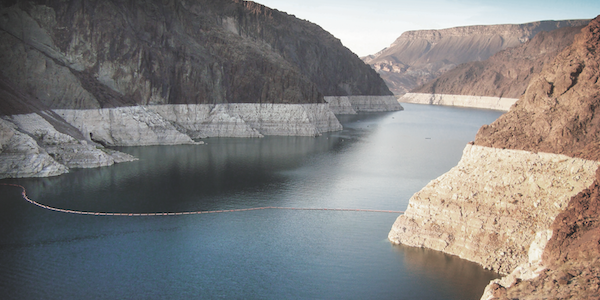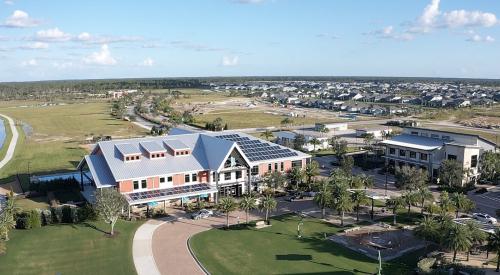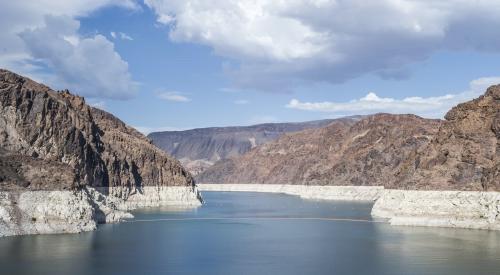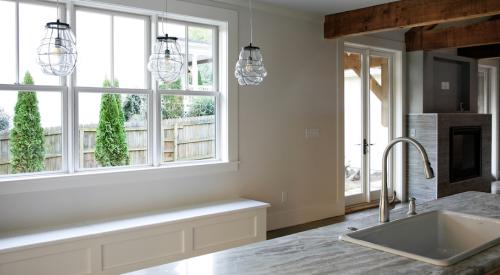FLUID MEASURE
Water is the only resource on earth that’s irreplaceable, and it’s in short supply. No construction restrictions yet, but tighter usage regs could be in the offing.
By John Caulfield, Senior Editor
This past summer, Massachusetts endured its worst drought in more than a decade, with 168 towns facing restrictions on nonessential outdoor water usage. The city of Worchester, whose reservoir system was at 55 percent capacity, imposed emergency restrictions that banned all outdoor water use and required builders to file variances to use water for jobsite dust control or to draw water from existing fire hydrants. But home building soldiered on. In metro Boston, water-use restrictions haven’t impeded Cutting Edge Homes, a design/build firm that builds between 15 and 18 homes per year. “Over the past six months, we’ve been concentrating on how to handle a resurgence in business,” said owner Sean Cutting. He hopes the drought is an anomaly.
This summer, most of Utah’s 48 reservoirs were extremely low, with a dozen empty or close to it. But Ivory Homes, the state’s biggest builder, hasn’t encountered any water-shortage-related constraints, says construction manager James Jonsson. He conceded that he might be singing a different tune if the state has another below-average year of snow melt.
And in northwestern New York, which has seen uncommonly dry weather, building has proceeded apace at Forbes Capretto Homes, based near Buffalo, which builds about 60 houses a year. “We’re in the Great Lakes Basin, so we have lots of water,” said William Tuyn, Vice President of Development and Diversity. But he was quick to note that statewide regulations now require developers and builders to control the volume of jobsite rainwater runoff to preconstruction levels. And because of the area’s high clay content and low permeability, his company often needs to truck in special soil and build an underground water catchment system.
Drought conditions are no longer confined to California, Nevada, and Arizona. Yet around the country, builders say they aren’t being boxed in by water shortages. With few exceptions—such as East Palo Alto, Calif., which this year imposed a moratorium on new development because it didn’t have enough water, which put 11 projects on hold—parched municipalities are not stopping residential construction from occurring.
“There is a huge political will not to stop development,” said Susan Dell’Ossa, project manager with Cambray Group, whose 5,000-acre River Islands community in Lathrop, Calif., will include 11,000 homes when it’s completed. But development requires patience: New communities in California with more than 500 homes must demonstrate water availability “in perpetuity.” It took Cambray 14 years to obtain a water source for River Islands, which included kicking in half of the $40 million the city of Lathrop paid to share a 40-mile pipeline to gain access to the water it needed.
In August, California lifted the water-use restrictions it imposed in the summer of 2015 for most of its larger water districts. And several other western states are recovering from drought conditions this year. But builders shouldn’t get lulled into a false sense of security: Most experts see more dry weather and scarcity ahead. A 2014 General Accountability Office survey found that 40 of 50 state water managers expect their states to have water shortages in the next decade. “Thirty years ago, California had more water than it knew what to do with,” recalled Robert Raymer, technical director for the California Building Industry Association (CBIA) in Sacramento. “Any builder who thinks they have an unlimited resource needs to ask themselves ‘what if things change?’ ”
Saving Water Saves Energy
That question isn’t likely to get asked, though, as long as water remains dirt cheap, which is still the case in many areas of the country. Dell’Ossa says water in her market is billed at around $3 per 1,000 gallons. In the absence of incentives to conserve voluntarily, the U.S. housing market has produced modest water-saving gains. The Water Research Foundation, in a study released in April that evaluated 23,749 homes served by 23 utilities nationwide, found that annual indoor household water use had been reduced by 22%, to 138 gallons per day, from levels in a similar study conducted in 1999.
Later this year, the Residential Energy Services Network (Resnet) plans to publish a Water Efficiency Rating (WER) Index Standard that Steve Baden, its Executive Director, says will be a companion to Resnet’s HERS rating for energy efficiency. Resnet’s goal is to measure the water efficiency of 100,000 homes per year, and its standard will become an ANSI standard through an agreement with the International Code Council. “This will give home buyers another metric to use when assessing their purchase, and builders a way to monetize water saving,” said Baden. The rating might also provide builders with ammunition when presenting development or construction plans to municipalities that are taking long-range water allocation into greater account.
Reducing water usage can have a positive effect on energy consumption, too. The UC Davis Center for Water-Energy Efficiency calculates that 20% of California’s electricity and more than 30% of its natural gas go toward water delivery. And the first three months of California’s statewide water conservation period saved more energy (460 GWh) than the total first-year savings from the state’s energy efficiency programs (459.4 GWh).
Later this year, the Residential Energy Services Network (Resnet) plans to publish a Water Efficiency Rating (WER) Index Standard that Steve Baden, its Executive Director, says will be a companion to Resnet’s HERS rating for energy efficiency. Resnet’s goal is to measure the water efficiency of 100,000 homes per year, and its standard will become an ANSI standard through an agreement with the International Code Council. “This will give home buyers another metric to use when assessing their purchase, and builders a way to monetize water saving,” said Baden. The rating might also provide builders with ammunition when presenting development or construction plans to municipalities that are taking long-range water allocation into greater account.
While drought conditions have yet to curtail new-home construction, they affect what’s getting built. Bill Christiansen, program manager for the Alliance for Water Efficiency, says his group is already seeing jurisdictions changing their water policies to require that new developments offset their projected water demand with water efficiency measures to create a “Net Zero” or neutral result. In Colorado Springs, Colo., Level 1 Homes, which builds about 12 homes per year, typically digs wells for water access. To get permitted to tap into the Dawson aquifer in the Denver Basin system, wells are equipped with consumption monitors whose data are sent to the state annually. Clint Dufresne, Level 1’s President, said this requirement has led his company to landscape its homes’ two-acre properties with much smaller lawns and more xeriscaping and drip irrigation.
Level 1 is among 130 builders that participate in the EPA’s WaterSense program, which is celebrating its 10th anniversary this year. Through 2015, more than 16,000 models of products have been WaterSense labeled. Through the second quarter of 2016, 797 labeled homes were reporting their water- and energy-saving performances to EPA. Several states and code organizations specify the use of WaterSense labeled products. And EPA wants to develop a water score that complements Energy Star’s energy score. Where WaterSense falls short, though, is its brand awareness. Less than one-quarter of Americans know what it is. A 2015 study commissioned by the Plumbing Manufacturers International found that only 7 percent of all toilets installed nationwide meet WaterSense standards, compared to 25.4 percent of faucets and 28.7 percent of showerheads.
Jacob Atalla, Vice President of Sustainability for KB Home, WaterSense’s highest-profile member, hasn’t seen evidence that customers come to KB specifically because of its involvement in this program. But participating in WaterSense is part of the production builder’s larger strategy to promote its homes as more efficient, and to be able to prove that to municipalities in the event water-use regs get tougher. “You have to respond to current and future realities,” he said. On its jobsites, KB uses reclaimed or recycled water for dust mitigation. Its model homes are landscaped with drought-tolerant plants. It went beyond WaterSense by specifying a restrictive-flow water faucet and then exploring its impact on consumer usage. Atalla added that KB is trying to do more with drip irrigation, and allow homeowners to control this via their mobile devices. And the builder specifies a low-flow lav sink faucet as its standard across the country.
Infrastructure Repair: A Costly Dilemma
Tennessee is going through some unexpected dry spells. But when Nashville-based Ole South Properties runs into snags over a property it wants to buy, it’s often less to do with water avaiLability than with permitting issues that, according to Dan Bobo and Roger Case, the builder’s development manager and COO, revolve around a town’s lack of infrastructure. Water conservation is only as effective as the distribution network that delivers it. And in the U.S., an overburdened and antiquated water infrastructure is badly in need of repair and replacement.
Black & Veatch, which specializes in infrastructure development, quotes the American Society of Civil Engineers estimate that, by 2020, there could be an $85 billion gap between the current level of spending and needed investments in treatment plants, pipes, and wet weather management. EPA believes that gap, left unaddressed, could reach more than $300 billion by 2036.
What will it take for the country to stop kicking this can down the road and muster the political will and public support to find $1.7 trillion to fix its existing infrastructure by 2050, plus another $1 trillion to expand the network to meet population and urbanization shifts? Baden thinks public-private partnerships could be one answer and is convinced that homeowners will demand action if their water bills keep escalating. “Whether there are droughts or not, the U.S. will need to address its water infrastructure issues,” says Atalla. PB
Making Water Reuse Feasible
In most markets, graywater reuse is still a bridge too icky for consumers to cross. But that could change as codes evolve: Four international plumbing and building codesnow require that water reuse systems used for toilet and urinal flushing comply with NSF/ANSI 350 to ensure proper treatment of graywater. Cambray Group has been encouraging its four builders—Van Daele Homes, Kiper Homes, Tim Lewis Communities, and The New Home Company—to install Nexus’ graywater system for outdoor irrigation. Del’Ossa claimed its system reduces water usage for a family of three by 200 gallons per day. But the builders are balking at what it would add to the home’s selling price, so Cambray, through its local Reclamation District, is trying to secure a low-interest loan so it could rent the graywater systems to homeowners for around $25 to $30 per month.
Home Creations in Normal, Okla., is considering graywater reuse for its largest project to date, Destin Landing, a 762-acre Planned Unit Development where 2,700 of 3,500 homes will be built. California is in the process of implementing a “purple pipe” recycling mandate for the 15 percent of its 500-plus jurisdictions that have access to a centralized water recycling plant. (The reg goes into effect July 2018.) CBIA’s Raymer added that the state is considering a mandate for in-home graywater reuse, although health concerns still need to be addressed. As shortages attract attention, and as water and sewer rates have been rising at a 12 percent annual clip nationally, according to Resnet, solutions are arriving that offer homeowners ways to clean and conserve water.
• HydroTech is a water-treatment system that prevents scales from forming inside pipes. Pete Baldwin, the Fort Worth, Texas-based supplier’s founding partner, explained that his product is especially useful in markets where people are turning to groundwater and well water “that can be pretty hard.” The system can also help kill bacteria and pathogens from recaptured rainwater. HydroTech recently started pursuing the housing market.
• WaterSignal is a leak monitor and detector that’s been installed in multifamily properties in 22 states. (The U.S. loses more than 1.7 trillion gallons per year from infrastructure and household leaks, according to the American Society of Civil Engineers). David Taylor, Senior Vice President-Operations for this Georgia-based supplier, conceded that his product’s penetration is strongest in markets with higher water rates. But more property managers want to position their apartments positively with environmentally conscious Millennials. WaterSignal is in the R&D phase of developing a product for single-family homes.
• Nexus eWater, has been in the U.S. for about 18 months after launching in Australia in 2009 and has been piloted by KB Home. The product cleans water by injecting air to create foam that moves contaminants—mostly soap—to the surface. Tom Wood, Nexus’ Co-founder and CEO, said his company markets its products primarily through builders, but its price tag, $10,000, is an obstacle. His company is pushing builders to at least make their new homes “recycle ready,” so the system could be installed at a later date.
The Next Level
A renovation in northern California focuses on extreme efficiency.
Sustainability and wellness are the new catchphrases for residential and commercial construction. A prime example of how these aspirations can produce high performance results is in the San Francisco Bay area, where a renovation of a 5,000-square-foot, four-bedroom home features conservation measures that reduced its indoor water use, from the LEED Homes 2009 baseline, by 33%, and its outdoor water use by 61%.
The renovation team—McCutcheon Construction, Andrew Mann Architecture, Sherry Williamson Design, Scott Lewis Landscape Architecture, Homestead Design Collective, and Healthy Building Science—worked closely with the owner, an artist, to define the parameters of the project and create a responsible environment with a precise aesthetic. Alex Hodgkinson, McCutcheon Construction’s Vice President, believes this renovation could be a model for future projects.
Indoor water savings were achieved primarily with high-performance low-flow fixtures. “The public may think that you sacrifice function if you ‘upgrade’ to low-flow fixtures, but these all perform incredibly well,” says architect Sherry Williamson, the project designer. A rainwater harvesting system by Carlile Macy and Siteworks includes a 40,000-gallon underground cistern, built using a modular load-bearing stacking system wrapped in a flexible membrane. It stores water collected from the home’s roof and runoff from a uphill neighboring property. The water is filtered and UV treated, and sent back to the house to supply toilets and the laundry. The cistern includes an automatic sensor that triggers a refill from city water when the level drops too low for the system to function.
The consultants also designed a graywater recapture system to irrigate the lawn. The system collects wastewater from showers, laundry, and bathroom sinks (but not the kitchen), which is cleaned through a four-stage process that entails nylon and UV filters. Horticultural experts selected drought-tolerant plants. “The client saw this project as an exploration of what was feasible with current products and technologies, and to see how far the team could go with sustainability,” said Andrew Mann, the architectural firm’s owner. “Given our arid climate in California, along with changes due to global warming and a growing population, there is increased stress on our municipal water systems. The lessons I take from this house are how to find the appropriate goals for a client in the design of their home, how to meet the restrictions inherent in the California Building Code, and what systems, materials and products solve those problems responsibly.”
LOT SHOCK
Land constraints have builders looking at parcels they might never have considered before.
By Pat Curry
"Psst! Hey, buddy! I got some Class A entitled lots for sale here. You interested?”
Finding lots isn’t that hard yet. But these days a builder might be tempted to at least stop and listen to that offer. In May, 64 percent of builders told the NAHB/Wells Fargo Housing Market Index that the supply of lots in their market was low or very low, the highest that percentage has been since NAHB started asking in 1997. “Even back in 2005 when the rate of housing starts was roughly twice that of today’s rate, the share of builders reporting shortages was around 53 percent,” NAHB economist Paul Emrath wrote in announcing the index.
From Seattle to Chicago to Atlanta, the shortage of Class A lots—and the prices being asked for available ones—is forcing builders to think way outside the box.
Getting Creative
The Olson Company, a builder/developer that focuses on southern California’s coastal region, takes a can-do approach. Recently Olson turned a former Sriracha hot sauce plant into a site for 88 townhomes. A 120-unit project next to the I-5 was carved out of a former RV park. Parking lots, warehouses, sites with power lines or railroad tracks: you name it, he’ll look at it. “There’s always something on the land or challenges with the surrounding areas,” says president and CEO Scott Laurie. “We do a lot of demolition and cleanup that is environmentally related.”
In Chicago, Lexington Homes is taking a similar tack. One project was built on the site for a former bowling alley; another site was a truck terminal. “Every piece we’ve done post-recession has been existing parcels, things in a no-man’s land,” says principal Jeff Benach.
Being Nimble
Demand is high and prices are going nowhere but up. In Seattle, Dwell Development principal Anthony Maschmedt is paying $250,000 to $300,000 for lots that cost half that much five years ago.
Colby Henson, manager for Fortress Builders in the Atlanta suburb of Marietta, Georgia, reports that prices for acquisition are rising every quarter, something he hasn’t seen since 2005. Developers and builders are scouring the market for anything they can find. “We’re looking at every little piece of land along I-285 that didn’t look desirable before,” Henson says. “If you can buy four or five houses, you can put them together to net 40 lots for townhomes. Before, it was too much brain damage.”
Even in perennial green field markets, such as Texas, builders are facing land acquisition challenges like never before. As a result, Houston-based Trendmaker Homes has taken an egalitarian approach to land acquisition and development. “You may say you only want to do a project of 1,000 acres,” says president Will Holder. “Then you find 75 acres and say, ‘Wow, let’s do that!’ We’ve done projects of 3,000 acres and projects of less than 100 lots. If anybody has land to show, Trendmaker wants to see it, even if it’s less than ideal. “Next year, they may have something perfect for us. We have a very big front door.”
Rethinking the Rules
Because of the shortage of lots and the prices being paid for them, builders obviously want to go vertical as quickly as possible. But government agencies aren’t doing much to ease entitlement and permitting. “There are always new regulations, and lots of issues with water quality,” says Tom Dallape, principal of Irvine, Calif.-based land brokerage firm The Hoffman Group. “That always has an impact on lot yield. It doesn’t get any easier.” Builders have done a good job in this recovery in buying land conservatively, and the land deals that are taking place are happening because “buyers and sellers have collaborated to get these things across the finish line,” Dallape says. He sees sellers offering financing, supplying infrastructure, and giving buyers early entry to development prior to closing. “We’ve been involved in every one of those kinds of deals in the last 18 months,” he says.
The time frames involved with getting entitlements have led The Olson Companies to set a rule that it doesn’t close on a parcel until it’s entitled, unlike some of their competitors. “More builders are taking on entitlement risks,” Laurie says. “The risk I see people taking on is much greater for the returns they’re seeing,” Laurie says.. We’re looking for higher returns for higher risk. We’re seeing competitors taking lower returns for higher risk.”
Builders also are taking a long, hard look at location, bypassing municipalities that make the process unnecessarily difficult or lengthy, and trying to do multiple projects in places where they’ve established a presence. “If you’ve taken two years to do the first project in a community, you’d be stupid not to be looking for other opportunities,” says builder/developer Jerry S. James, president of Edward R. James Companies in Glenview, Ill. “If you do a good job, you can get invited back. If you’re just hopscotching from one community to another, that’s a long road.”
Evolving Capital Sources
If there’s some good news here, it’s that after the near-total shutdown of acquisition, development, and construction financing during the recession, established builders are able to find financing, whether it’s equity or straight debt.
National banks essentially are still shying away from lending to builders, but regional and community banks are doing some deals close to home, and private money is available. “We’ve seen a decent appetite from hedge funds and private money sources to finance acquisition from initial take down through entitlement to even some infrastructure to get sites graded to blue top,” says Shlomi Ronen, founder and managing principal of Los Angeles-based Dekel Capital. Ronen mentions a client that purchased a 20-acre site that’s in the entitlement process in the San Fernando Valley. Ronen’s firm is getting the client 70 percent cost financing priced at 10 percent and two points. “That’s kind of typical,” Ronen says. “They’re doing better than 50 percent (financing) typically. The project needs a clear path toward approval with lots being sellable to a builder.”
Financing partners want to work with developers or builders with experience that is “very specific to the city and the market,” Ronen says. “The age of the company is less material than the experience of the team involved in taking the site through the process. That’s the key.”
Summit Homes of Nevada has partnered with San Diego-based Presidio Residential Capital to finance its projects in the Las Vegas market. “I’d classify them as a hedge fund,” says division manager Nathan White. “We have no bank loans. It’s all equity.” Summit has focused on smaller projects of nine to 36 units, which allows them to finish the deals more quickly. “That helps our internal rate of return,” White explains. “That is very important in how Presidio evaluates projects; shorter projects reduce risk.”
The downside of doing small projects, White notes, is that he needs to constantly find new lots and start new projects.The benefits? Less exposure to the risk of another market downturn and less competition for the land. “A lot of the public companies have decided not to buy small parcels,” he says. “It’s worth it for us.”
Resourcefulness Redefined
An impressive result of the land shortage is innovation. In State College, Pa., scarcity, regulations and the sheer cost of infrastructure led S&A Homes to design a line of single-family, detached houses with garages to fit a 40-foot lot instead of the standard 60-foot width. “Most of the time people live in their front or back yard. A narrower lot gives them deeper back yards where they can have patios and fire pits. Plus, it helps keep infrastructure costs low,” says Chris Schoonmaker, president of S&A’s housing division.
Summit Homes has carved out a niche building on the two ends of the spectrum from the sweet spot of its publicly traded competitors—attached product on the low end and luxury product on the other. One of its latest communities boasts homes on 20,000-square-foot lots for buyers with horses and RVs. Prices are in the $1 million range. The builder has also started buying land auctioned off by the federal Bureau of Land Management, primarily because most of the public builders in the market don’t have corporate approval to shop there. “Some have been able to get approval, but very, very few,” White says. “We have flexibility.”
Pat Curry is a freelance writer based in Augusta, Georgia. She specializes in writing about housing.
POWER PLAY
Rising costs and extreme weather drive a search for new sources of traditional and renewable energy
By Michael Chamernik, Associate Editor
Utility prices have risen, and if the short-term outlook from the U.S. Energy Information Administration and the National Renewable Energy Laboratory is any indication, they will continue to do so. The retail price of residential power will rise from 12.52 cents per kilowatt hour (kWh) in 2014 to about 12.98 cents per kWh in 2017, an average household increase of around $55 per year.
Homeowners may not notice when power is there, but they sure notice when it’s not. Extreme weather and earthquakes prompt questions about emergency preparedness and the state of the grid. When marketing homes to a new generation of buyers, builders are aware that energy smarts aren’t just something that’s nice to have—it’s increasingly a feature of a new home that’s simply assumed to be there. But where is the power coming from, and how do builders deliver it to homeowners?
The Sources
Currently, coal and natural gas continue to power the nation’s electrical supply. Some 4.09 trillion kWh of net electricity was generated in 2015. Of that, roughly 33 percent came from coal, another third from natural gas, and 19.5 percent from nuclear electric power. Of the renewables, conventional hydroelectric power contributed 6.1 percent, wind 4.6 percent, and solar power just 0.6 percent, though solar is on an upswing. Utility-scale solar jumped from 1.21 billion kWh in 2010 to 26.47 billion kWh last year. Distributed solar—electricity produced at or near the point where it’s used, from rooftops or small-scale ground-mounted installations—has gradually risen in the residential sector, from 762 million kWh in 2010 to 5.93 billion kWh in 2015.
A Cue From California
California led the nation during the energy crisis of the 1970s and is doing so again, making a strong push toward renewables with an aggressive goal to have half the state’s electricity provided by renewable resources by 2030. California’s Title 24 energy code mandates that all new single-family homes must be Zero Net Energy (ZNE)—meaning that the amount of energy provided on-site by renewable energy sources is equal to the amount of energy used—in less than four years. Builders in the state are setting themselves up for Jan. 1, 2020 well in advance.
Fresno, Calif.-based De Young Properties builds homes packed as tightly as possible with insulation and EnergySmart features, such as HVAC and water heater systems (EnergySmart is RESNET’s standard). In Los Angeles, Dahan Properties stresses eco-friendly design and uses reclaimed wood and recycled tile. The Olson Company, based in Southern California, has been obtaining LEED certifications for homes since 2007. All three companies power houses with distributed solar via PV panels. Dahan’s CEO, Mayer Dahan, is especially inventive with solar. He uses roofing systems, parapet roofs, and unique angles to hide the solar panels, giving the buyer a house that is as green as it is aesthetically pleasing. “Most customers have a full solar panel deck on their house but have never seen it,” Dahan says.
According to Dahan, eco-friendly features increase building costs between 5 and 7 percent. For Scott Laurie, CEO of The Olson Company, increased cost can turn off buyers. Laurie is trying to get his costs under control, and land is too much of a factor. He says fewer homes will be solar standard in the next few years because buyers won’t spend that extra 5 percent to 10 percent. “The green that is the most interesting to people is the green in their pockets,” he adds.
Brandon De Young, executive VP for De Young Properties, says that appraisers have been inaccurate when valuing solar systems for lenders, offering, for example, only half retail price. The remainder can’t be financed in the home loan, so the buyer needs to pay it in cash. “My biggest fear is that the codes, as they get closer to zero net energy, may potentially force first-time homebuyers out of the market in the short-term because of that extra up-front cost,” he says. “Builders aren’t going to just absorb the increased cost to achieve zero net energy and not also increase sales prices to account for it. At the end of the day, we still need to make money to survive.”
Plummeting Prices
Yet the cost of solar power has dropped 70 percent since 2009. The price for factory-fresh modules used for flush-mounted through-roof residential racking decreased by more than half last year. Pricing for inverters and photovoltaic panels has dropped from about $7 to $3 since 2009. Tax credits, rebates, and other government initiatives can cut the total costs of a rooftop system to less than $10,000. Net metering allows customers to offset energy costs by transferring surplus power back to the grid. What’s more, delivery methods go beyond roof panels.
Owning Solar
Lennar, the second-largest home builder in the U.S., has its own solar subsidiary. Through SunStreet Energy Group, Lennar can offer solar in 10 states and 19 metros; it comes with 90 percent of new communities in California. Photovoltaic panels are installed during the construction process. During a 110-day build schedule, installers will arrive around day 40 to perform all the solar jobs. Crews will take a week to install the modules right after the roof is tiled but before the home is painted, and the system is activated during the final electric inspection. Sun Street lets Lennar monitor installs and handle quality assurance.
“By incorporating solar as standard up front,” says Mike Dufault, the senior VP of operations at SunStreet, “and putting it into a whole community, we make everything look pleasing from the get-go and don’t have to worry about a solar company coming in later with a retrofit and messing up the aesthetics.”
Farms Versus Rooftops
Large-scale solar, such as Babcock Ranch (see Farming the Sun, below) can be the most practical choice for master planned communities. Contract durations are flexible, homeowners needn’t assume up-front costs and then lose money when they relocate, and rooftop space isn’t an issue. Utility solar can be cheaper: In 2015, the price was $0.10 per kW, half that of residential solar. “You don’t have to do individual engineering for every few kilowatts of power,” says Dr. Elaine Ulrich, a program manager at the DOE who leads a team that works to reduce solar’s soft costs, such as business management and installation. “The financing is a bit easier for utilities. All of that can lead to a lower cost for a large-scale solar farm, as opposed to residential scale.”
But finding the hundreds of acres needed for large-scale solar can be difficult, while for rooftop solar, support structures are factored in. “It’s very cost effective to bolt solar panels onto that structure that’s angled and oriented to collect sun,” says C.R. Herro, Meritage Homes’ VP of energy efficiency and sustainability. Rooftop solar requires no additional space, hook-up or transmission lines, additional buffering, or load-following. Despite the up-front cost to homeowners, homes with rooftop PV panels could provide tens of thousands of dollars of savings over 25 years of life. “Distributed solar has the cost effectiveness and direct benefit to the consumer to fund it that utility-level solar lacks,” Herro says.
Farming the Sun
Located 20 miles outside of Fort Myers, Fla., Babcock Ranch will be an 18,000-acre community of around 20,000 homes, situated around a central downtown with 6 million square feet of retail and office, along with nearly 150,000 acres dedicated to a nature preserve and wildlife management area. The community will draw energy via a new 75-megawatt solar facility that will contain 350,000 photovoltaic panels in a nearby 440-acre site. For Syd Kitson, the chairman and CEO of Kitson & Partners and the developer of Babcock Ranch, utility-scale solar simply makes sense. The price of panels has shrunk over recent years, and the payoff of tax advantages for rooftop PV takes more time than large-scale solar.
Kitson’s group partnered with Florida Power & Light, which owns the solar plant. All the transmission lines were in place, and the solar farm is on the premises. Construction started on phase one of the 25-year project late in 2015, and the first of the eventual 50,000 residents will arrive in January. The design took hurricanes into account, with resilient community area safe spaces and a location 20 feet above sea level—above the storm surge. Kitson is convinced that Babcock Ranch can be replicable on a smaller scale. “If it’s thought about up front, and if it’s part of the infrastructure up front, I think the costs can be much less if it becomes part of the fabric of the community,” Kitson says. “We hope that others will do that.”


















